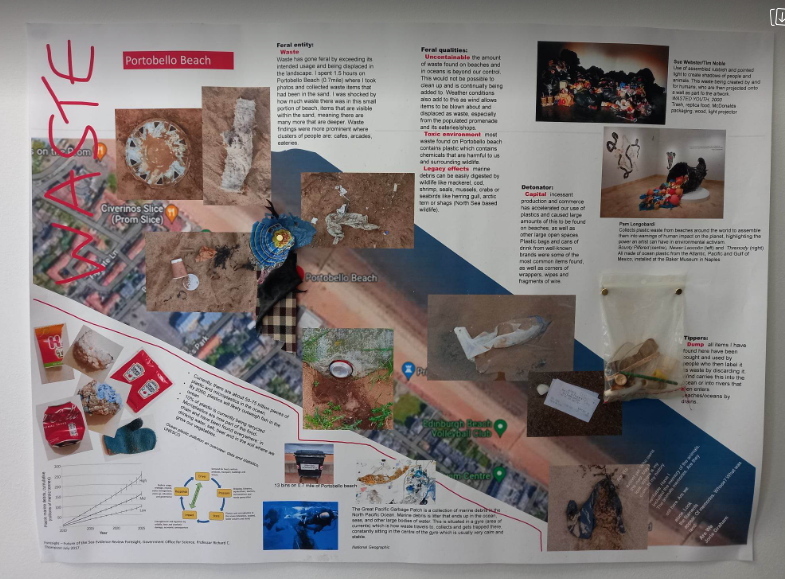
My research poster which displays my findings of waste on Portobello Beach. I go to this beach frequently so it was interesting to get a new perspective of a place that I have seen and walked on multiple times. It was shocking to discover the amount of small plastics that are within the sand of the beach, mostly lightweight items like sweet wrappers and straws, and although I collected many items, there was too much to pick up. Despite the large number of bins along the promenade, there was much waste to be found and collected for the poster. I made sure to thoroughly research waste and marine pollution to give a wider and global context to the findings on Portobello Beach. There were some shocking facts that I put onto the poster which made these findings and the process of collecting all the more important and valid, situating Portobello Beach within the wider issues of human impact. I spent approximately 2 hours on the beach taking photos and collecting items, taking notes of where these items were found and what places, like cafes, shops, were nearby to them. Much more concentrated areas of waste were near to rows of cafes and arcades, places where most people and single-use plastics are found. Other factors that I took into consideration was the high level of wind speed they have in this area, a massive factor in how waste can travel big distances and fatally end up in oceans. I found the Feral Atlas’ use of specified terminology like detonators, tippers and feral qualities really useful for determining the various aspects of this research and how each individual aspect of an issue determines others. The placement of the photographs onto the large googlemaps image, signifies where I took them and that they are, deemed by myself, the worst offenders I came across; it was shocking to come across a heavy-duty plastic bag wrapped around a large rock that can only be seen when the tide is out, this cannot be moved so continues to be polluting the sea every day. I thought it important to include artists practices in this poster who explore themes of waste and marine pollution. Sue Webster and Tim Noble were the first to come to mind for theyre intricately thought out and humorous assemblages of various waste items, especially that of McDonalds and Coco-Cola. Pam Longobardi focuses much more on marine plastics, creating beautiful installations that adorn gallery walls, with a very real intention of bringing ocean pollution to the forefront of discussion. How artists and poets react to such issues can be very informative of collective thinking and introduces a way for everyone to enter discussions and debates, avoiding autocratic scientist voices. Overall I really enjoyed this project especially being able to contribute to a discussion by reporting findings and adding artist voices to these.


Leave a Reply